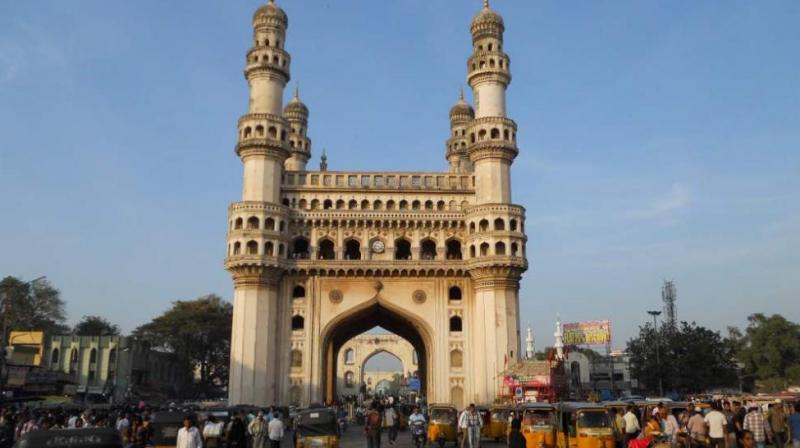Hyderabad was Bhagnagar, but politicians still differ

HYDERABAD: In the 2020 GHMC elections, one issue that almost dominated the election campaign for the civic body was the name of Hyderabad.
Uttar Pradesh Chief Minister Yogi Adityanath, who was one of the BJP’s star campaigners, declared: “... we renamed Faizabad as Ayodhya and Allahabad as Prayagraj after BJP came into power in Uttar Pradesh. Then why can’t Hyderabad be renamed as Bhagyanagar?”
Looking at Adityanath’s statement as an attempt to change the identity of the city, MIM president Asaduddin Owaisi retorted: “... Your entire generation will end but Hyderabad’s name will remain Hyderabad, the elections are between Hyderabad and Bhagyanagar...”
The issue of Bhagyanagar did not die down as Prime Minister Narendra Modi during the BJP’s executive meeting in Hyderabad in July 2022, referred to Hyderabad as Bhagyanagar.
Many Telugu-speaking people have been calling Hyderabad Bhagyanagar informally for ages. It was used in art, literature, cinema and political debates conducted in Telugu. For example, a song in Akkinenni Nageswara Rao’s movie Vichitra Bandham, released in 1972, featured a song, Vinara Andhra Kumara Bhagyanagara Gadha, on the history of Bhagyanagar written by the lyricist Aatreya, who was a freedom-fighter and social reformer. Its use never invited opposition from any quarter.
However, when the BJP had decided to champion the issue, it alarmed a section of people, leading to many people floating theories denying the connection between Hyderabad and Bhagyanagar. It has split people into two groups with extreme stands, influenced primarily by politics. However, as historical fact requires dispassionate analysis, it would be ideal to check through the annals of history to find out the truth.
One of the earliest references to ‘Bhagnagar’ was made by an English merchant William Finch of the East India Company, who visited Golconda between 1608 and 1611 (17 years after Hyderabad was founded). His memoirs recorded in the book ‘Early Travels in India, 1583-1619’, he said Bhagnagar was the chief city of Golconda.
The Antiquities of Bidar (1944) by Dr Ghulam Yazdani referred to an usurper of the Bidar throne, Mirza Ali Barid, fleeing to ‘Bhagnagar’ in 1601.
The Nizam Government’s magazine Islamic Culture in its April 1934 edition, quoted Prof. Rai Bahadur Surya Kumar Bhuyan’s translation of a letter written by the Mughal emperor Shah Jahan to the Adil Shahi sultan, where the Mughal emperor refers to ‘Bhagnagar’.
Francois Bernier, a French physician who toured India between 1656 and 1668, quoted the Golconda vazir (prime minister) Mir Jumla’s letter to the then Mughal prince Aurangazeb in his book, Travels in the Mogul Empire, 1656-1668. In the letter, Jumla was quoted as requesting Aurangazeb to attack Bhagnagar to help him to escape the wrath of the Qutub Shahis.
The Islamic Culture published by Nizam’s Government in 1943, stated that one Muhammad Zahid Beg, who had copied the Yusuf Zulaikha, ascribed the date and place at the end of his work as follows: “On Monday, the 24th Dhu’l-Hajja, year 1067 A.H. in the city of ‘Bhagnagar’.” The Hijri year 1067 refers to the year 1656 in the Gregorian calendar.
In his book ‘The Oriental Biographical Dictionary’, which was published in 1881, Thomas William Beale quoted Mughal historian Khafi Khan to state that sometime after the death of Bhagmati, the name of ‘Bhagnagar’ was changed to Haidarabad, but that in the vernacular language of the people it continued to be ‘Bhagnagar’.
In Tarikh-i Sultan Muhammad Kutbshahi (1617 AD), its author, who remained anonymous, mentioned that “Abu al-Fath Sultan Muhammad Kuli Kutb Shah, who built Bhagnagar or Haidarabad and transferred his capital from Gulkundah, to the newly-erected city...”
The Nizam Government’s Islamic Culture magazine quoted Bakhshi Nizamuddin Ahmad of writing the following in Tabaqat-i-Akbari in 1003 AH (1592 CE): “Muhammad Quli succeeded his father. He became the lover of a prostitute of the name Bhagmati, and having laid the foundation of a city and called it Bhagnagar. He had one thousand horsemen as the retinue of that woman.”
Speaking on December 27, 1951, during the inaugural session of the 14th Indian Political Science Conference, at the Arts College Hall of Osmania University, Vice-Chancellor Nawab Ali Yawar Jung Bahadur, said, “Many of you are visiting Hyderabad and this University presumably for the first time. It is in many ways a beautiful city with a fascinating history. Founded in 1589 by Mohamad Quli Qutub Shah, it was originally named ‘Bhagnagar’.”
To clear the air of confusion over whether Bhagnagar and Bhagyanagar are the same, one needs to bear in mind that words get corrupted in their colloquial form. Enquiries from Hindi and Sanskrit dictionaries show that Bhag and Bhagya have the same meaning, which is good fortune, and not a garden as some people began to suggest in the wake of politicisation of Bhagyanagar.
In conformity with the meaning of Bhagnagar, the Mughal emperor Shah Alam I ordered coins be minted with the phrase ‘Farkhunda Buniyad-i-Hyderabad’ to celebrate his victory over his rival and half-brother Kambaksh in 1708 CE near Mir Jumla tank, which supposedly existed near the present-day Talab Katta near Charminar.
According to the Persian-English dictionary, farkhunda means happy; fortunate, and prosperous, and buniyaad means foundation. So the phrase farkhunda buniyad as suggested by Shah Alam I would mean the foundation of good fortune, which is the same meaning that Bhagnagar or Bhagyanagar have and clearly sets to rest theories that try to alter history by giving a new meaning to Bhagnagar.

